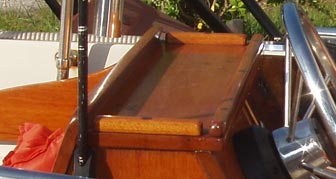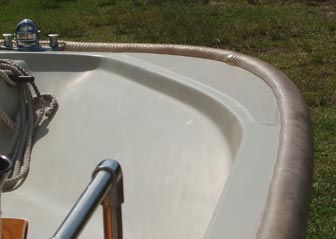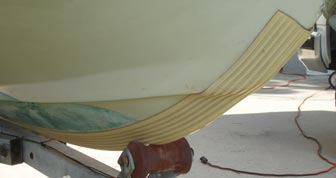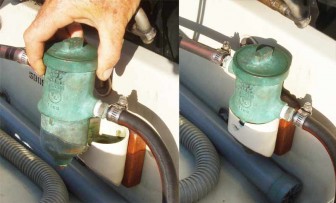Modifying and Upgrading My Boston Whaler
 I added little wood rails around the top of the mahogany console. It works to keep drinks, handheld GPS, and other small items from sliding off the console.
I added little wood rails around the top of the mahogany console. It works to keep drinks, handheld GPS, and other small items from sliding off the console.

I wrap this 2" plastic food grade suction hose around the rub rail on my Boston Whaler. It's the clear hose with a white PVC spiral inside it.

This keel protector gives me peace of mind whenever I need to beach the boat

In this photo you can see the mahogany forward thwart bench seat with grab handles, the cut-off bow rail, the little wood rails on the console, the fishing rod holders, and the water skiing mirror. And the cup holders, of course.
After I converted the 15' Boston Whaler from a Super Sport back to a Sport, I decided the boat was a keeper, and I would modify it some more to suit the way we like to use the boat. My wife and I frequently use the boat by ourselves, and there is no need for the forward bench seat, so it usually stays home.
We use the boat for water skiing, so we have a ski mirror mounted on the side of the console, along with 3 Bar Buoy swiveling drink holders mounted on the console and the port side mahogany rail.
We also use the boat for fishing, so I mounted two stainless steel rodholders on the stainless steel side rails.
The boat has a canvas Bimini top with aluminum frame which folds aft. I have actually sailed a 15' Boston Whaler by hanging the Bimini top forward.
Mahogany Rails on the Console Are Quite Useful
When I removed all the wood for refinishing, I found rot around almost every screw. The nice finish washers that Whaler uses on each screw hold water, resulting in rot over time. I had to drill them out and glue in bungs cut from mahogany dowels of various sizes. I also removed the small compass from the console and filled those holes while I was at it.
Once that was done, I put little mahogany rails, called fiddles, around the perimeter of the console, leaving each corner open for drainage. This keeps small items such as my handheld GPS from sliding off.
The front of the console still has the nice angled backrest for the forward bench seat, rather than the low, square console found on the Sport. I put grab handles into the center of the mahogany thwart bench seat, so passengers can hang on with both hands, not that my driving makes that necessary or anything...
Rubrail Protection
The rubrail on Boston Whalers will eventually get worn out and must be replaced, but I learned a way to protect the rubrail and the boat from a guy in Miami Beach Marina. He had slit a piece of 2" plastic food grade suction hose and simply wrapped it around the rub rail on his Boston Whaler.
I went to Amazon Hose Company immediately and bought some hose to copy his idea. It's the clear hose with a white PVC spiral inside it. I mark a line, cut it with a jigsaw, and spend a couple of hours grunting, prying, pulling, and pushing it on. It wraps completely around the rub rail and the plastic rubrail molding on the top, and around the drip edge on the bottom side.
This provides additional protection all the way around the boat. When the boat bumps against a piling, the hose cushions and spreads out the impact before it ever reaches the rub rail. I have used this on an 11' Boston Whaler and a 15' Boston Whaler for years.
The only problem is that the PVC suction tubing has absolutely no resistance to UV light, and deteriorates in a couple of years. When it starts to go bad, it turns black and sticky, and if you touch it, you need mineral spirits or WD-40 to remove the goo from your hands. Fortunately, the tubing isn't expensive, and I just buy some more whenever it needs replacing. I consider it part of the routine costs of boat ownership.
Protecting the Keel
We launch most often at a small ramp without a dock, so I beach the boat on the sand when fetching the trailer. It used to make me cringe, knowing that I was sanding away the gelcoat on the hull. I bought a keel protector strip to protect the hull. It is very tough, and I no longer worry about letting the boat hit the sand. I took great care when installing it to properly prepare the surface and to roll the strip onto the hull with no bubbles or separation.
I rolled out the pressure-activated cement and put a bead of the special caulk provided around the edge of the hull guard, but it is still separating a bit at the aft end. I think it was pulled loose by the trailer roller, but it doesn't cause any real problem, and I will eventually glue it back down.
Protecting the Fuel
I have had my experiences with bad fuel, so all of my boats get a good water separating fuel filter. On the 15 Whaler, I use a bronze fuel filter made by Perko, mounted in a PVC sleeve that I fabricated and mounted on a small block of mahogany on the transom in the motor well. It is easy to slide it out to remove the drain plug and flush out any water or debris that may have collected. The fuel filter element is a bit hard to find, but seldom needs replacing.
Odds and Ends
The boat is self bailing when on plane, but at rest will fill up the aft section of the boat with an inch or so of water, depending on how much fuel I have aboard. With people aboard, it takes on a bit more, so I carry the small Thirsty Mate bilge pump in case I need to empty out small amounts of water.
Up in the bow locker, I keep my boating tool kit, a life jacket, and some rode attached to a plastic anchor which may look odd, but it works great and won't scar the boat.

Excellent project and congratulations on the results, it looks like a lot of effort went int making those improvements to the whaler. Thank you for sharing your challenge with us. Looking forward to reading more.